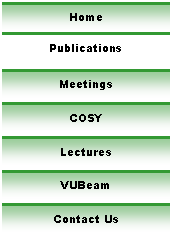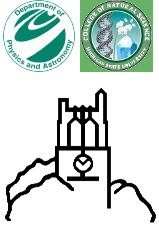
|
Reprint Server |



Optimization of Accelerator Parameters using Normal Form Methods on Higher-Order Transfer Maps
A Dissertation
In partial fulfillment of the requirements for the degree of Doctor of Philosophy from Michigan State University.
Abstract
Methods of analysis of the dynamics of ensembles of charged particles in collider rings are developed. The following problems are posed and solved using normal form transformations and other methods of perturbative nonlinear dynamics:
- Optimization of the Tevatron dynamics:
- Skew quadrupole correction of the dynamics of particles in the Tevatron in the presence of the systematic skew quadrupole errors in dipoles;
- Calculation of the nonlinear tune shift with amplitude based on the results of measurements and the linear lattice information;
-
Optimization of the Muon Collider storage ring:
- Computation and optimization of the dynamic aperture of the Muon Collider 50x50 GeV storage ring using higher order correctors;
- 750x750 GeV Muon Collider storage ring lattice design matching the Tevatron footprint.
The normal form coordinates have a very important advantage over the particle
optical coordinates: if the transformation can be carried out successfully (general
restrictions for that are not much stronger than the typical restrictions imposed on the
behavior of the particles in the accelerator) then the motion in the new coordinates has
a very clean representation allowing to extract more information about the dynamics
of particles, and they are very convenient for the purposes of visualization.
All the problem formulations include the derivation of the objective functions,
which are later used in the optimization process using various optimization algorithms.
Algorithms used to solve the problems are specific to collider rings, and applicable to
similar problems arising on other machines of the same type.
The details of the long-term behavior of the systems are studied to ensure the
their stability for the desired number of turns. The algorithm of the normal form
transformation is of great value for such problems as it gives much extra information
about the disturbing factors. In addition to the fact that the dynamics of particles
is represented in a way that is easy to understand, such important characteristics
as the strengths of the resonances and the tune shifts with amplitude and various
parameters of the system are calculated.
Each major section is supplied with the results of applying various numerical
optimization methods to the problems stated. The emphasis is made on the efficiency
comparison of various approaches and methods. The main simulation tool is the
arbitrary order code COSY INFINITY written by M. Berz, K. Makino, et al. at
Michigan State University. Also, the code MAD is utilized to design the 750x750 GeV
Muon Collider storage ring baseline lattice.
The OptiM to COSY lattice converter is written specifically for the need of the
studies included into the dissertation, and tested on the Tevatron accelerator lattice.
P. Snopok (2007)
Download
Click on the icon to download the corresponding file.
![]() Download Adobe PDF version (4591336 Bytes).
Download Adobe PDF version (4591336 Bytes).
Go Back to the reprint server.
Go Back to the home page.
This page is maintained by Kyoko Makino. Please contact her if there are any problems with it.